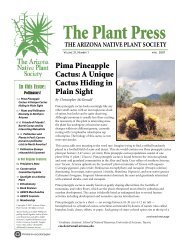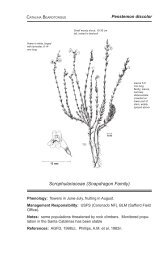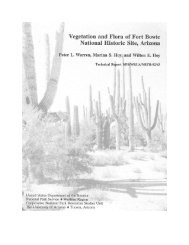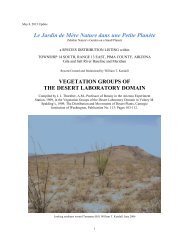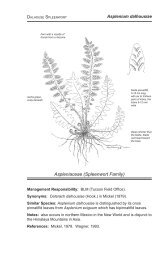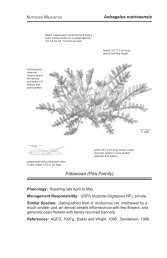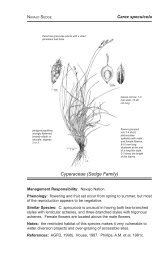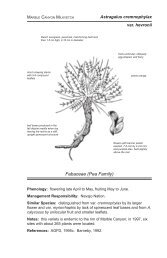ocky-gravelly-loamy, gravelly, gravelly-loamy and clayey-loamy roadsides; seeps; springs; along streams; sandy streambeds;along and in rocky-cobbly creeks; creekbeds; along rivers; along and in gravelly and sandy washes; drainages; freshwatermarshes; depressions; swales; (rocky) banks of streams, rivers, riverbeds and washes; (rocky) edges of ponds and lakes; marginsof washes; benches; terraces; bottomlands; floodplains; lowlands; stock tanks; canals; canal banks; along ditches; silty ditchbanks; bouldery and sandy riparian areas; waste places and disturbed areas growing in wet, moist and dry bouldery, rocky, rockycobbly,rocky-sandy, gravelly and sandy ground; rocky loam, rocky-gravelly loam, cobbly-sandy loam, gravelly loam, sandyloam, clayey loam, silty loam and loam ground; bouldery clay, rocky clay, loamy clay and clay ground, and silty ground,occurring from sea level to 8,300 feet in elevation in the forest, woodland, scrub, grassland, desertscrub and wetland ecologicalformations. NOTES: EXOTIC Invasive <strong>Plant</strong> which poses a significant threat to our native biotic communities. This plant wasreported to have been utilized by native peoples of North America; it was noted as having been used for food. Seed can remaindormant in soil for as long as 10 years. Avena fatua is native to Europe; Asia, and northern Africa. *5, 6, 15, 16, 33 (Page 166),43 (092709), 44 (032611 - color photograph), 46 (Page 100), 56, 57, 63 (092709 - color presentation), 68, 77, 85 (101311 - colorpresentation), 89 (reported under Miscellaneous Introduced Species as being a winter annual herb), 101 (color photograph), 124(032611), 127*Bothriochloa barbinodis (M. Lagasca y Segura) W.G. Herter: Cane BluestemSYNONYMY: Andropogon barbinodis M. Lagasca y Segura. COMMON NAMES: Algodoneso (Spanish: Mexico) 140 ;Barbed Beard Grass (Oklahoma); Barbed Beard-grass (Oklahoma); Beard-grass (a name also applied to other species and thegenus Bothriochloa); Bristlejoint Bluestem; Cane Beard Grass; Cane Beard-grass (English) 140 ; Cane Beardgrass; Cane Bluestem;Cola de Coyote (“Coyote’s Tail”, Spanish: Nuevo León) 140 ; Feather Bluestem; Feather Grass; Fuzzy Top; Fuzzy Top Beardgrass;Fuzzy-top; Palmer’s Cane Bluestem; Perforated Bluestem; Pin-hole Beard Grass; Pinhole Beardgrass; Pinhole Bluestem; PittedBeardgrass; Plains Beardgrass; Popotillo [Perforado, Plateado] (“[Perforated, Folded] Little Broom”, Spanish: Sonora) 140 ;Popotillo Algodonero (Spanish); Silver Beardgrass; Tł’oh (“Grass” a word used for any grass, Athapascan: Western Apache) 140 ;Waháɨ (“Grass” a word used for any grass, Uto-Aztecan: Northern Paiute) 140 ; Waṣai (“Grass” a word used for any grass, Uto-Aztecan: Tohono O’odham) 140 ; Ya-jewel-g-ute (Havasupai); Zacate Popotillo (“Little Broom Grass”, Spanish: Mexico) 140 ;Zacatón (Hispanic). DESCRIPTION: Terrestrial perennial graminoid (a bunchgrass (clumpgrass) with decumbent and/or erect tospreading culms 20 inches to 5 feet in height; one plant was observed and described as being 4 inches in width at the base); thefoliage is bluish-green or yellow-green curing to a dull red, reddish-brown or yellow; the spikelets (flowers) are tawny-green ortan; the silvery-white inflorescences are oblong to fan-shaped; flowering generally takes place between late March and earlyDecember (additional records: one for early February and one for mid-February). HABITAT: Within the range of this species ithas been reported from rocky mountains; rocky and gravelly mesas; plateaus; along cliff faces; rocky and gravelly-loamycanyons; along bedrock, bouldery-sandy, rocky, rocky-sandy, gravelly, gravelly-sandy and sandy canyon bottoms; rocky chasms;rocky bases of cliffs; crevices in bedrock, boulders and rocks; buttes; ledges; rocky and sandy-loamy ridges; rocky ridgetops;clearings in woodlands; meadows; cinder cone peaks; rocky foothills; rocky hills; rocky and gravelly hillsides; escarpments;rocky, rocky-loamy, gravelly, gravelly-sandy-loamy, gravelly-loamy, gravelly-clayey, gravelly-clayey-loamy, sandy, sandyloamy,sandy-clayey, sandy-clayey-loamy and clayey-loamy slopes; bases of slopes; bajadas; rocky outcrops; amongst bouldersand rocks; sand dunes; sandy plains; gravelly, sandy, sandy-clayey and clayey flats; rocky valley floors; railroad right-of-ways;clayey roadbeds; along gravelly, gravelly-loamy, sandy and silty-clayey-loamy roadsides; along rocky, stony and sandy arroyos;sandy bottoms of arroyos; sandy-clayey-loamy draws; gullies; ravines; seeps; springs; along sandy streams; along and inbouldery streambeds; along creeks; along and in creekbeds; along rivers; within bouldery-cobbly-sandy riverbeds; along and inrocky, rocky-gravelly, cobbly-sandy-loamy, gravelly, gravelly-sandy, gravelly-loamy, sandy and clayey washes; within gravellysandy-loamydrainages; within rocky drainage ways; ciénegas; swales; rock tanks; along (sandy) banks of creeks, rivers, washesand lakes; (sandy) edges of creeks; bouldery-sandy and sandy beaches; benches; rocky and gravelly terraces; bottomlands;floodplains; mesquite bosques; stock tanks; along and in ditches; bouldery-cobbly-sandy, rocky and sandy riparian areas, anddisturbed areas growing in moist and dry rocky desert pavement; bouldery, bouldery-cobbly-sandy, bouldery-gravelly, boulderysandy,rocky, rocky-gravelly, rocky-sandy, stony, cobbly-sandy, gravelly, gravelly-sandy and sandy ground; rocky loam, rockyclayeyloam, cobbly-sandy loam, gravelly loam, gravelly-sandy loam, gravelly-clayey loam, sandy loam, sandy-clayey loam,clayey loam, silty-clayey loam and loam ground; gravelly clay, sandy clay and clay ground, and silty ground, occurring from sealevel to 7,500 feet in elevation in the forest, woodland, scrub, grassland, desertscrub and wetland ecological formations. NOTES:This plant may be an attractive component of a restored native habitat and is extremely drought-resistant and tolerant of coastalconditions. Pronghorn (Antilocapra americana) browse this plant. Bothriochloa barbinodis is native to southwest-central andsouthern North America; Central America, and western and southern South America. *5, 6, 15, 16, 30, 33 (recorded asAndropogon barbinodis Lag., Page 306), 43 (092709), 44 (032711), 46 (recorded as Andropogon barbinodis Lag., Page 142), 48,58, 63 (092709 - color presentation), 77, 85 (101511 - color presentation), 89 (reported as being a perennial herb located onTumamoc Hill, recorded as Andropogon torreyanus Steud.), 105 (recorded as Andropogon barbinodis Lag.), 124 (032711), 140(Pages 198-199 & 299)*Bouteloua aristidoides (K.S. Kunth) A.H. Grisebach: Needle GramaCOMMON NAMES: Aceitilla (Spanish); Navajita; Needle Grama; Needle Grama Grass; Needle Gramma;Needlegrama; Pasto de Cabra (Spanish); Six Weeks Grama Grass; Six Weeks Needle Grama; Six-weeks Needle Grama;Sixweeks Needle Grama; Tochite (Spanish); Zacate Saitillo. DESCRIPTION: Terrestrial annual tufted graminoid (decumbentand/or geniculate culms 2 to 24 inches in height); the foliage is light green or purple curing to straw; the flowers are purplish; the34
anthers are yellow or yellow & red; flowering generally takes place between mid-July and late October (additional records: twofor early January, one for late January, one for early February, one for early March, one for mid-March, five for early April, onefor late April, one for early May, one for mid-November, two for late November and one for late December). HABITAT: Withinthe range of this species it has been reported from mountains; mountainsides; sandy mesas; sandy mesas; cliffs; along rockycanyons; canyon bottoms; chasms; bluffs; ridges; meadows; rocky hills; rocky-gravelly hilltops; rocky hillsides; sandy bases ofescarpments; rocky, rocky-gravelly, rocky-clayey-loamy, gravelly, gravelly-sandy, gravelly-sandy-loamy, gravelly-clayey,gravelly-clayey-loamy, sandy, sandy-loamy, sandy-clayey, sandy-silty and clayey-loamy slopes; gravelly bajadas; rocky coves;sand hills; sand dunes; sand hummocks; sand dunes; in blow sand; edges of dune fields; plains; rocky, gravelly, sandy and sandyloamyflats, basins; clayey valley floors; loamy valley bottoms; coastal dunes; gravelly, gravelly-sandy, sandy and sandy-loamyroadsides; within arroyos; sandy bottoms of arroyos; stony-sandy draws, seeps; springs; along streams; streambeds; creekbeds;along rivers; sandy riverbeds; along and in rocky, gravelly, gravelly-sandy, sandy, clayey and silty-clayey washes; withindrainages; ciénegas; depressions; (sandy-loamy) banks of washes; margins of washes; (rocky-sandy) shores of lakes; benches;gravelly deltas; sandy terraces; loamy bottomlands; sandy and silty floodplains; clayey lowlands; sandy mesquite bosques;riparian areas; waste places, and disturbed areas growing in dry rocky desert pavement; bouldery, rocky, rocky-gravelly, rockysandy,stony-sandy, gravelly, gravelly-sandy and sandy ground; rocky-clayey loam, gravelly-sandy loam, gravelly-clayey loam,sandy loam, clayey loam and loam ground; gravelly clay, sandy clay, silty clay and clay ground, and sandy silty and silty ground,occurring from sea level to 8,000 feet in elevation in the woodland, scrub, grassland, desertscrub and wetland ecologicalformations. NOTES: The Six-weeks Needle Grama is a favored food of the Rufous-winged Sparrow (Aimophila carpalis).Bouteloua aristidoides is native to southwest-central and southern North America. *5, 6, 15, 16, 30, 33 (Page 141), 43 (092809),44 (032711), 46 (Page 128), 56, 57, 58, 63 (052809 - color presentation), 68, 77, 85 (101611 - color presentation), 89 (reported asbeing a summer annual herb located on the Mesa-like Mountain Slopes), 105, 124 (032711 - no record of species; genus record),140 (Pages 200 & 299), WTK (October 23, 2009)*Bouteloua barbata M. Lagasca y Segura: Sixweeks GramaSYNONYMY: Bouteloua barbata M. Lagasca y Segura var. barbata. COMMON NAMES: Annual Six WeeksGrama; Low Grama; Low Grama Grass; Low Gramma; Low Gramma Grass; Navajita (Spanish); Navajita Anual (Spanish); SandGrama; Six Weeks Grama; Six-weeks Grama; Six-weeks Grass; Sixweeks Grama; Zacate Liebrero (Spanish). DESCRIPTION:Terrestrial annual tufted graminoid (a bunchgrass (clumpgrass) with ascending and/or erect and spreading culms ½ to 18 inchesin height); the foliage is light green or dark violet curing to straw; the spikelets (flowers) are purplish, red-green or reddish;flowering may take place throughout the year, but occurs mostly between late July and late November (additional records: onefor mid-January, one for early February, two for mid-February, one for early March, one for mid-March, one for late March, twofor late April, one for early July, two for mid-December and two for late December). HABITAT: Within the range of this speciesit has been reported from mountains; mountaintops; gravelly mountainsides; gravelly and sandy mesas; sandy bases of cliffs;rocky canyons; canyon bottoms; talus; sandy crevices in bedrock; buttes; ledges; rocky ridgetops; meadows; along foothills;bouldery, rocky, rocky-sandy, gravelly and sandy hills; rocky-gravelly hilltops; rocky hillsides; sandy bases of escarpments;rocky, rocky-gravelly, gravelly, gravelly-sandy-clayey, gravelly-clayey, sandy, sandy-loamy, sandy-clayey, clayey and clayeyloamyslopes; rocky and gravelly alluvial fans; sandy bajadas; rocky outcrops; amongst rocks; sandy lava flows; sand hills; sanddunes; sand hummocks; margins of dunes; blow-sand deposits; gravelly debris fans; prairies; sandy plains; rocky, rocky-sandy,gravelly, gravelly-sandy, gravelly-sandy-loamy, gravelly-loamy, sandy, sandy-loamy, clayey and silty flats; basins; sandy andsandy-clayey valley floors; valley bottoms; beach dunes; sandy coastal plains; shell mounds; along railroad right-of-ways; rockygravellyroadbeds; along rocky-gravelly, cobbly, gravelly, sandy and sandy-clayey-loamy roadsides; along and in sandy arroyos;bottoms of arroyos; draws; gullies; along streams; streambeds; along sandy creeks; sandy riverbeds; along and in rocky, gravelly,sandy and silty-clayey washes; along and in sandy drainages; along waterways; pebbly-sandy waterholes; oases; sandy and siltylakebeds; sandy playas; depressions; swales; along (gravelly and sandy) banks of rivers and washes; edges of washes andlakebeds; (rocky-sandy) shores of lakes; mudflats; sand bars; sandy-clayey-loamy beaches; benches; gravelly terraces;bottomlands; sandy floodplains; mesquite bosques; around stock tanks (charcos/represos); silty ditches; sandy ditch banks; sandyriparian areas; gravelly waste places, and disturbed areas growing in dry desert pavement; bouldery, bouldery-sandy, rocky,rocky-gravelly, rocky-sandy, cobbly, gravelly, gravelly-sandy, pebbly-sandy and sandy ground; rocky loam, gravelly loam,gravelly-sandy loam, sandy loam, sandy-clayey loam and clayey loam ground; gravelly clay, gravelly-sandy clay, sandy clay,silty clay and clay ground, and sandy silty and silty ground, occurring from sea level to 8,000 feet in elevation in the forest,woodland, scrub, grassland, desertscrub and wetland ecological formations. NOTES: This plant may be an attractive componentof a restored native habitat. Sixweeks Grama (annual) may be confused with the short-lived perennial Rothrock Grama(Bouteloua rothrockii). Bouteloua barbata is native to southwest-central and southern North America. *5, 6, 15, 16 (recorded asBouteloua barbata Lag. var. barbata), 33 (Page 153), 43 (092909), 44 (032711), 46 (Page 127), 57, 58, 63 (092809 - colorpresentation), 68, 77, 85 (101611 - color presentation), 89 (reported as being a summer annual herb located on the Mesa-likeMountain Slopes, recorded as Boutloua polystachya (Benth.), 105, 124 (032711), 140 (Page 299 - recorded as Bouteloua barbataLagasca var. barbata)*Bouteloua barbata var. barbata (see Bouteloua barbata)Bouteloua barbata var. rothrockii (see Bouteloua rothrockii)35
- Page 1: May 8, 2013 Updatea SPECIES DISTRIB
- Page 6 and 7: Historic Neighborhoods: Historic Ne
- Page 9 and 10: Sand Dropseed (Poaceae: Sporobolus
- Page 11 and 12: Spreading Fleabane (Asteraceae: Eri
- Page 13 and 14: Southwest Rare Plant Task Force to
- Page 15 and 16: ock walls; rocky and gravelly-loamy
- Page 17 and 18: sandy-clayey-loamy and clayey slope
- Page 19 and 20: streams, and disturbed areas growin
- Page 21 and 22: Yellow Nutgrass (a name also applie
- Page 23 and 24: also applied to other species, Atha
- Page 25 and 26: ocky-gravelly-clayey-loamy and ston
- Page 27 and 28: Dichelostemma pulchellum), 89 (see
- Page 29 and 30: Aristida hamulosa (see Aristida ter
- Page 31 and 32: along and in creekbeds; riverbeds;
- Page 33: mountains; rocky mountainsides; roc
- Page 37 and 38: ecological formations. NOTES: This
- Page 39 and 40: tufted graminoid (erect culms 4 to
- Page 41 and 42: SYNONYMY: Bromus diandrus A.W. Roth
- Page 43 and 44: oadcuts; along rocky, rocky-gravell
- Page 45 and 46: and sandy ground and sandy loam and
- Page 47 and 48: 6, 15 (recorded as Erioneuron pulch
- Page 49 and 50: along (gravelly, sandy and muddy) e
- Page 51 and 52: Long-bristle Wild Rye; Mono’pü (
- Page 53 and 54: SYNONYMY: Pappophorum wrightii S. W
- Page 55 and 56: amongst boulders; dunes; gravelly p
- Page 57 and 58: Eragrostis tephrosanthos (see Eragr
- Page 59: Festuca octoflora (see Vulpia octof
- Page 62 and 63: Hordeum pusillum T. Nuttall: Little
- Page 64 and 65: as Leptochloa filiformis (Lam.) Bea
- Page 66 and 67: applied to other species); Beardles
- Page 68 and 69: Muhlenbergia porteri F.L. Scribner
- Page 70 and 71: ground; rocky clay, gravelly clay,
- Page 72 and 73: Panicum saccharatum (see footnote 8
- Page 74 and 75: ocky-sandy loam and loam ground, an
- Page 76 and 77: September, three for mid-September,
- Page 78 and 79: takes place between early March and
- Page 80 and 81: along rocky, gravelly and clayey-lo
- Page 82 and 83: gravelly washes; within drainages;
- Page 84 and 85:
exposed to drouth or disease which
- Page 86 and 87:
mountains; gravelly mountaintops; b
- Page 88 and 89:
generally described as taking place
- Page 90 and 91:
from sea level to 4,800 feet in ele
- Page 92 and 93:
dry bouldery, rocky, rocky-gravelly
- Page 94 and 95:
September (additional records: one
- Page 96 and 97:
as Siphonoglossa longiflora (Torr.)
- Page 98 and 99:
gravelly-sandy canyons; rocky and s
- Page 100 and 101:
enzymatic action.”), 77, 80 (This
- Page 102 and 103:
in the woodland, scrub, grassland,
- Page 104 and 105:
drainage ways; along banks of washe
- Page 106 and 107:
to sheep; however, the plants are s
- Page 108 and 109:
from sea level to 6,900 feet in ele
- Page 110 and 111:
Asteraceae (Compositae): The Aster
- Page 112 and 113:
and the genus Ambrosia); Slender Ra
- Page 114 and 115:
have been utilized by native people
- Page 116 and 117:
Aster subulatus var. ligulatus (see
- Page 118 and 119:
streams; streambeds; along gravelly
- Page 120 and 121:
levees; canals; canal banks; rocky
- Page 122 and 123:
Castalis tragus (W. Aiton) N.T. Nor
- Page 124 and 125:
presentation), 86 (color photograph
- Page 126 and 127:
photograph), 43 (111809), 44 (05171
- Page 128 and 129:
Sinaloa) 140 ; Hierba del Caballo (
- Page 130 and 131:
ouldery-stony-gravelly-sandy, rocky
- Page 132 and 133:
sandy clearings in forests and wood
- Page 134 and 135:
Franseria confertiflora (see Ambros
- Page 136 and 137:
orange; there are no ray florets; f
- Page 138 and 139:
Hemizonia pungens (see Centromadia
- Page 140 and 141:
Hierba del Burrow (a name also appl
- Page 142 and 143:
loam ground; silty clay and clay gr
- Page 144 and 145:
Terrestrial annual forb/herb (stems
- Page 146 and 147:
SYNONYMY: Xanthisma spinulosum (F.T
- Page 148 and 149:
(color photograph), 89 (reported as
- Page 150 and 151:
other species, Col. Springs, Califo
- Page 152 and 153:
loam and clayey loam ground; sandy
- Page 154 and 155:
around springs; along streams; stre
- Page 156 and 157:
mid-July). HABITAT: Within the rang
- Page 158 and 159:
SYNONYMY: Sonchus asper (C. Linnaeu
- Page 160 and 161:
(Page 960), 58, 63 (041812 - color
- Page 162 and 163:
and clay ground, and sandy silty an
- Page 164 and 165:
species it has been reported from m
- Page 166 and 167:
orientale); Californian Burr (var.
- Page 168 and 169:
drops rapidly as the first true lea
- Page 170 and 171:
streams; along sandy streambeds; al
- Page 172 and 173:
ocky and gravelly alluvial fans; gr
- Page 174 and 175:
Cryptantha pterocarya (J. Torrey) E
- Page 176 and 177:
Lappula occidentalis (S. Watson) E.
- Page 178 and 179:
sandy-clayey, loamy and clayey flat
- Page 180 and 181:
(Page 712), 58, 63 (051512 - color
- Page 182 and 183:
enchlands; flats; basins; along san
- Page 184 and 185:
disturbed areas growing in muddy gr
- Page 186 and 187:
COMMON NAMES: Desert Whitlow; Draba
- Page 188 and 189:
(062212 - color presentation), 77 (
- Page 190 and 191:
gravelly-sandy and sandy washes; dr
- Page 192 and 193:
purpurea is native to southwest-cen
- Page 194 and 195:
COMMON NAMES: Ban Cenṣañig (“C
- Page 196 and 197:
annual forb/herb (erect stems 4 to
- Page 198 and 199:
washes growing in dry rocky, rocky-
- Page 200 and 201:
Cylindropuntia leptocaulis (A.P. de
- Page 202 and 203:
Cylindropuntia x tetracantha is nat
- Page 204 and 205:
Cactus; Táci (Uto-Aztecan: Souther
- Page 206 and 207:
Opuntia engelmannii J.F. Salm-Reiff
- Page 208 and 209:
discata (Griffiths) L. Benson - “
- Page 210 and 211:
also applied to other species); Spr
- Page 212 and 213:
America and could be investigated t
- Page 214 and 215:
Koeberlinia spinosa J.G. Zuccarini
- Page 216 and 217:
is native to southwest-central and
- Page 218 and 219:
iparian areas, and disturbed areas
- Page 220 and 221:
commercial food, beverage and/or dy
- Page 222 and 223:
gravelly, gravelly-sandy and sandy
- Page 224 and 225:
to livestock where selenium occurs
- Page 226 and 227:
name also applied to the species);
- Page 228 and 229:
mid-March and mid-November (additio
- Page 230 and 231:
from 900 to 11,200 feet in elevatio
- Page 232 and 233:
ecological formations. NOTES: This
- Page 234 and 235:
Suaeda suffrutescens S. Watson (var
- Page 236 and 237:
COMMON NAMES: Red Morning-glory (a
- Page 238 and 239:
formations. NOTE: Crassula connata
- Page 240 and 241:
to 3,000 feet in elevation in the s
- Page 242 and 243:
SYNONYMY: Euphorbia abramsiana L.C.
- Page 244 and 245:
two for late December). HABITAT: Wi
- Page 246 and 247:
appendages; flowering generally tak
- Page 248 and 249:
the woodland, grassland and deserts
- Page 250 and 251:
mid-January and mid-May and again b
- Page 252 and 253:
COMMON NAMES: Limberbush; Matacora;
- Page 254 and 255:
native habitat, the leaves are fern
- Page 256 and 257:
also applied to other species); Dev
- Page 258 and 259:
March and late May (additional reco
- Page 260 and 261:
Astragalus nuttallianus A.P. de Can
- Page 262 and 263:
Cassia bauhinioides (see Senna bauh
- Page 264 and 265:
gravelly-sandy-silty, gravelly-loam
- Page 266 and 267:
and scrub, and disturbed areas grow
- Page 268 and 269:
summer or on the trail), or by graz
- Page 270 and 271:
nothosubsp. varia); Sichelklee (Ger
- Page 272 and 273:
other species, Portuguese: Brazil);
- Page 274 and 275:
located on Tumamoc Hill), 91 (recor
- Page 276 and 277:
desertscrub and wetland ecological
- Page 278 and 279:
Vicia ludoviciana T. Nuttall (subsp
- Page 280 and 281:
genus or species), 127, 140 (record
- Page 282 and 283:
Rosita. DESCRIPTION: Terrestrial an
- Page 284 and 285:
of the Mediterranean region having
- Page 286 and 287:
and clayey washes; sandy-silty play
- Page 288 and 289:
Phacelia coerulea Auct.), 44 (12281
- Page 290 and 291:
Parry Scorpion-weed; Safirfacelia (
- Page 292 and 293:
(010713 - color presentation), 89 (
- Page 294 and 295:
ocky valley floors; along rocky-gra
- Page 296 and 297:
chaparral and coastal sage scrub, a
- Page 298 and 299:
species it has been reported from m
- Page 300 and 301:
Mentzelia jonesii (I. Urban & E.F.
- Page 302 and 303:
height with a crown 40 inches in wi
- Page 304 and 305:
Anoda thurberi (see footnote 89 und
- Page 306 and 307:
ange of this species it has been re
- Page 308 and 309:
gravelly and sandy canyons; along s
- Page 310 and 311:
presentation including habitat; rec
- Page 312 and 313:
Molluginaceae: The Carpetweed Famil
- Page 314 and 315:
sandy, cobbly-pebbly, cobbly-sandy,
- Page 316 and 317:
(reported as being a summer annual
- Page 318 and 319:
also applied to other species and t
- Page 320 and 321:
Fraxinus velutina var. toumeyi (see
- Page 322 and 323:
Munz), 48 (genus, recorded as Oenot
- Page 324 and 325:
presentation), 77, 85 (022013 - col
- Page 326 and 327:
Onagraceae); Hierba Cólica (Hispan
- Page 328 and 329:
lue-green, gray, grayish-green purp
- Page 330 and 331:
strands; along railroad right-of-wa
- Page 332 and 333:
maroon, orange, orange-brown, purpl
- Page 334 and 335:
(powdered roots carried in pocket t
- Page 336 and 337:
(031613), 46 (Page 804), 48 (genus)
- Page 338 and 339:
yellow; the anthers are blue; flowe
- Page 340 and 341:
presentation), 89 (reported as bein
- Page 342 and 343:
mountainsides; mesas; cliffs; bases
- Page 344 and 345:
alluvial fans; gravelly bajadas; ro
- Page 346 and 347:
sandy bottomlands; sandy floodplain
- Page 348 and 349:
generally takes place between mid-A
- Page 350 and 351:
may be green, greenish, greenish-pu
- Page 352 and 353:
Perfoliate Claytonia; Perfoliate Mi
- Page 354 and 355:
ground; gravelly loam, gravelly-sil
- Page 356 and 357:
Potosí) 140 ; Kava Vopar (Uto-Azt
- Page 358 and 359:
the stems may be green or pink-tan;
- Page 360 and 361:
(Athapascan: Western Apache) 140 ;
- Page 362 and 363:
Bouvardia ternifolia (A.J. Cavanill
- Page 364 and 365:
late August, one for early Septembe
- Page 366 and 367:
November 2, 2012, Landmark S. Ariz.
- Page 368 and 369:
(species, color photograph of the s
- Page 370 and 371:
ocky mesas; plateaus; hanging garde
- Page 372 and 373:
58, 63 (041713 - color presentation
- Page 374 and 375:
mountainsides; bouldery and gravell
- Page 376 and 377:
Blue Toad-flax; Large Blue Toadflax
- Page 378 and 379:
(English) 140 ; Quinine-plant; Shee
- Page 380 and 381:
silty swales; (sandy-silty) banks o
- Page 382 and 383:
sandy ground; rocky-sandy loam, san
- Page 384 and 385:
Lycium fremontii A. Gray: Frémont
- Page 386 and 387:
Coyote [Desert] Tobacco (English) 1
- Page 388 and 389:
Physalis acutifolia (J. Miers) N.Y.
- Page 390 and 391:
ocks; bedrock bottoms of caves; cla
- Page 392 and 393:
NOTES: This plant was reported to h
- Page 394 and 395:
Ayenia compacta J.N. Rose: Californ
- Page 396 and 397:
shores of lakes; mudflats; sand bar
- Page 398 and 399:
(Aphelocoma californica) feed on th
- Page 400 and 401:
have been utilized by native people
- Page 402 and 403:
native to southwest-central and sou
- Page 404 and 405:
Viscaceae (Loranthaceae): The Chris
- Page 406 and 407:
Apache) 140 ; U´li (Hispanic); U:d
- Page 408 and 409:
Kallstroemia hirsutissima A.M. Vail
- Page 410 and 411:
for mid-March, two for late March,
- Page 412 and 413:
Heraclides cresphontes (see Papilio
- Page 414 and 415:
it has been reported from freshwate
- Page 416 and 417:
Cathartes aura (Linnaeus, 1758): Tu
- Page 418 and 419:
Chondestes grammacus (Say, 1823): L
- Page 420 and 421:
and wetland ecological formations.
- Page 422 and 423:
formations. *14 (042212 - subsp. lo
- Page 424 and 425:
Icteria virens (Linnaeus, 1758): Ye
- Page 426 and 427:
species it has been reported from w
- Page 428 and 429:
Selasphorus rufus (Gmelin, 1788): R
- Page 430 and 431:
Vireonidae: The Vireo FamilyVireo b
- Page 432 and 433:
Ovis canadensis Shaw. Bighorn. Prob
- Page 434 and 435:
COMMON NAMES: Kit Fox; Desert Kit F
- Page 436 and 437:
White-tailed Deer (O.v. leucurus (D
- Page 438 and 439:
Felis yaguarondi (see Puma yagouaro
- Page 440 and 441:
cottontail rabbits, coyotes, deer (
- Page 442 and 443:
(Distribution: mapping and records
- Page 444 and 445:
Chaetodipus penicillatus subsp. pri
- Page 446 and 447:
118 (recorded as Perognathus flavus
- Page 448 and 449:
Mephitidae: The Skunk FamilyConepat
- Page 450 and 451:
desertscrub and wetland ecological
- Page 452 and 453:
(species), 100 (species, color phot
- Page 454 and 455:
present known only from a few scatt
- Page 456 and 457:
located in dens dug in banks or wit
- Page 458 and 459:
118 (recorded as Bassariscus astutu
- Page 460 and 461:
Citellus harrisii (see Ammospermoph
- Page 462 and 463:
Tayassu tajacu subsp. sonoriensis (
- Page 464 and 465:
Ursus horribilis subsp. texensis (s
- Page 466 and 467:
species), 100 (species, color photo
- Page 468 and 469:
townsendii, includes a listing of s
- Page 470 and 471:
Callisaurus draconoides Blainville,
- Page 472 and 473:
Plan website. Extensive revisions m
- Page 474 and 475:
(8) Arizona Game and Fish Departmen
- Page 476 and 477:
(17) Breitung, August J., The Agave
- Page 478 and 479:
(59) Medina, Alvin L. 2003. Histori
- Page 480 and 481:
(93) Udvardy, Miklos D.F. 1977. The
- Page 482 and 483:
(127) Native American Ethnobotany,
- Page 484:
(ANPS) Arizona Native Plant Society



